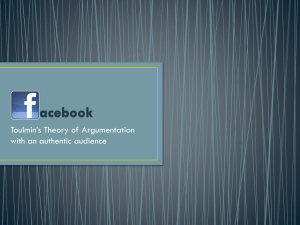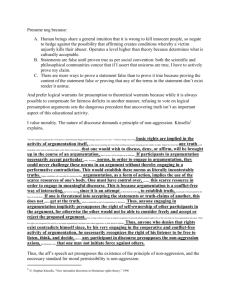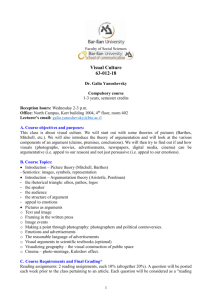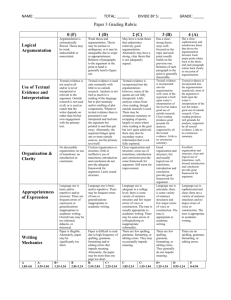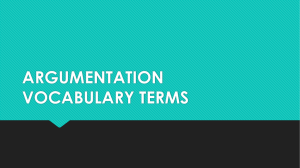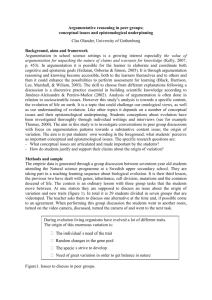Towards Large-Scale Argumentation
advertisement
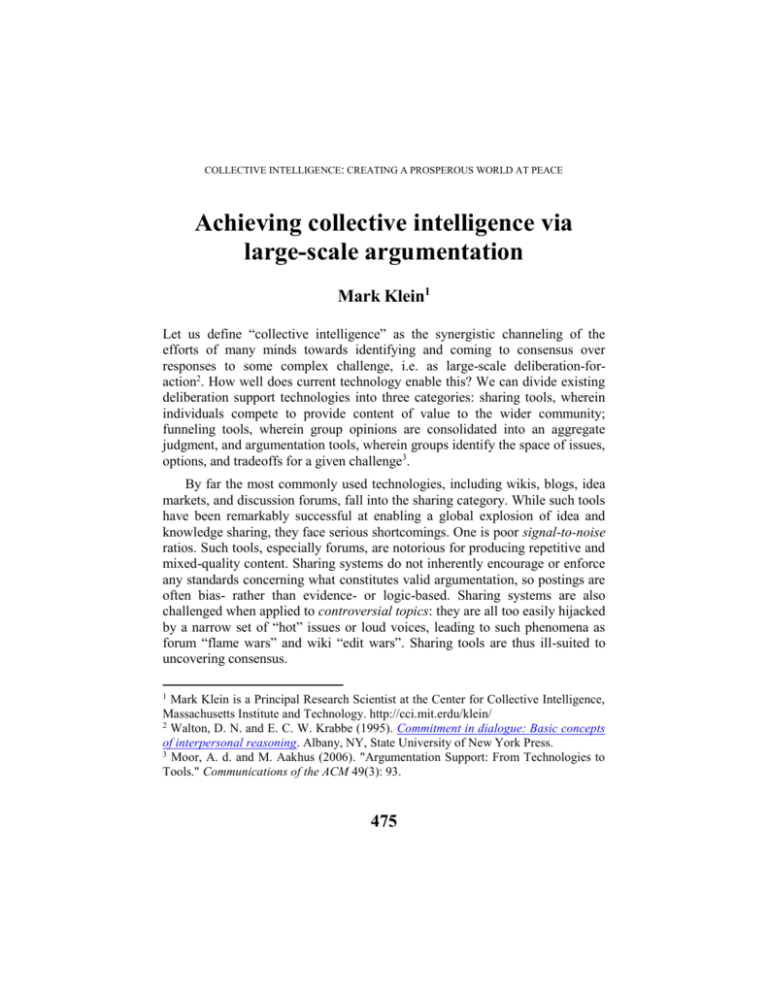
COLLECTIVE INTELLIGENCE: CREATING A PROSPEROUS WORLD AT PEACE Achieving collective intelligence via large-scale argumentation Mark Klein1 Let us define “collective intelligence” as the synergistic channeling of the efforts of many minds towards identifying and coming to consensus over responses to some complex challenge, i.e. as large-scale deliberation-foraction2. How well does current technology enable this? We can divide existing deliberation support technologies into three categories: sharing tools, wherein individuals compete to provide content of value to the wider community; funneling tools, wherein group opinions are consolidated into an aggregate judgment, and argumentation tools, wherein groups identify the space of issues, options, and tradeoffs for a given challenge3. By far the most commonly used technologies, including wikis, blogs, idea markets, and discussion forums, fall into the sharing category. While such tools have been remarkably successful at enabling a global explosion of idea and knowledge sharing, they face serious shortcomings. One is poor signal-to-noise ratios. Such tools, especially forums, are notorious for producing repetitive and mixed-quality content. Sharing systems do not inherently encourage or enforce any standards concerning what constitutes valid argumentation, so postings are often bias- rather than evidence- or logic-based. Sharing systems are also challenged when applied to controversial topics: they are all too easily hijacked by a narrow set of “hot” issues or loud voices, leading to such phenomena as forum “flame wars” and wiki “edit wars”. Sharing tools are thus ill-suited to uncovering consensus. 1 Mark Klein is a Principal Research Scientist at the Center for Collective Intelligence, Massachusetts Institute and Technology. http://cci.mit.erdu/klein/ 2 Walton, D. N. and E. C. W. Krabbe (1995). Commitment in dialogue: Basic concepts of interpersonal reasoning. Albany, NY, State University of New York Press. 3 Moor, A. d. and M. Aakhus (2006). "Argumentation Support: From Technologies to Tools." Communications of the ACM 49(3): 93. 475 MASS COLLABORATION AND LARGE SCALE ARGUMENTATION Funneling technologies, which include group decision support systems, prediction markets, and e-voting, have proven effective at aggregating individual opinions into a consensus, but provide little or no support for identifying what the alternatives selected among should be, or what their pros and cons are. Argumentation tools fill this gap, by helping groups define networks of issues (questions to be answered), options (alternative answers for a question), and arguments (statements that support or detract from some other statement)4 Figure 1. An example argument structure. Such tools help make deliberations, even complex ones, more systematic and complete. The central role of argument entities implicitly encourages the users to express the evidence and logic in favor of the options they prefer. The results are captured in a compact form that makes it easy to understand what has been discussed to date and, if desired, add to it without needless 4 Kirschner, P. A., S. J. B. Shum and C. S. C. Eds (2005). "Visualizing Argumentation: Software tools for collaborative and educational sense-making." Information Visualization 4: 59-60. 476 LARGE-SCALE ARGUMENTATION duplication, enabling synergy across group members as well as cumulativeness across time. Current argumentation systems do face some important shortcomings, however. A central problem has been ensuring that people enter their thinking as argument structures – a time and skill-intensive activity - when the benefits thereof often accrue mainly to other people at some time in the future. Most argumentation systems have addressed this challenge by being applied in physically co-located meetings where a single facilitator captures the free-form deliberations of the team members in the form of an commonly-viewable argumentation map5. Argumentation systems have also been used, to a lesser extent, to enable non-facilitated deliberations, over the Internet, with physically distributed participants6,7. With only one exception that we know of8, however, the scale of use has been small, with on the order of 10 participants or so working together on any given task, far less than what is implied by the vision of collective intelligence introduced in this paper. Towards Large-Scale Argumentation We hypothesize that effective collective intelligence that transcends these limitations can be achieved by creating large-scale argumentation systems, i.e. systems that integrate sharing and argumentation technologies to enable the systematic identification of solution ideas and tradeoffs on a large scale, and then use funneling to help participants come to consensus about which of these solution ideas should be implemented for a given problem. Creating such large- 5 Shum, S. J. B., A. M. Selvin, M. Sierhuis, J. Conklin and C. B. Haley (2006). Hypermedia Support for Argumentation-Based Rationale: 15 Years on from gIBIS and QOC. Rationale Management in Software Engineering. A. H. Dutoit, R. McCall, I. Mistrik and B. Paech, Springer-Verlag. 6 Jonassen, D. and H. R. Jr (2005). "Mapping alternative discourse structures onto computer conferences." International Journal of Knowledge and Learning 1(1/2): 113129. 7 T., V. Ratnakar and Y. Gil (2005). "User interfaces with semi-formal representations: a study of designing argumentation structures." Proceedings of the 10th international conference on Intelligent user interfaces: 130-136 8 This exception (the Open Meeting Project’s mediation of the 1994 National Policy Review) was effectively a comment collection system rather than a deliberation system. 477 MASS COLLABORATION AND LARGE SCALE ARGUMENTATION scale argumentations systems will require, we believe, coming up with novel solutions to a range of key design challenges, including: Who can edit what? This has been handled in a wide range of ways in different collaborative systems. Wikis, for example, typically allow anyone to change anything, where the last writer “wins”. In chat, email, and threaded discussion systems, every post has a single author; people can comment on but not modify submitted posts. Each scheme has different pros and cons. Which scheme is best for large-scale argumentation? How do we ensure a high-quality argument structure? In an open system, we can expect that many participants will not be experts on how to structure argument networks effectively. People may fail to properly “unbundle” their contributions into their constituent issues, options, and arguments, may link them to the wrong postings, or may fail to give them accurate titles. Different people may also conceptually divide up a problem space differently, leading to the possibility of multiple competing issue trees. The sheer volume of postings may make this redundancy less than obvious, and no single facilitator can be expected to ensure coherence since he/she would represent a bottleneck in a large-scale system. Getting the structure right, however, is a critical concern. A good structure helps make sure that the full space of issues ideas and tradeoffs is explored, and substantially reduces the likelihood of duplication. How do we mediate attention sharing? In a small-scale face-to-face setting, it is relatively straightforward to guide the group en masse through a systematic consideration of all the issues. Facilitators often play a key role in this. In a large-scale system, however, users may follow their own agendas, important issues may go neglected, or discussions may become balkanized, with subgroups each attending to distinct parts of the argument structure without interacting with each other. People, in addition, typically generate ideas by extending or re-combining ideas previously proposed by others. Our goal should be to maximize such potential synergy by helping them encounter a wide range of ‘fertile’ ideas. The requisite networked interaction is straightforward to ensure in small physically co-located meetings: how can we achieve it with large distributed settings, where communication often devolves into a broadcast topology? How do we enable consensus? In small-scale argumentation systems, consensus (i.e. about which of the proposed ideas should be adopted) emerges off-line via 478 LARGE-SCALE ARGUMENTATION the face-to-face interactions amongst the participants, but in a large-scale system, this consensus-making needs to be mediated or at least be made discernible by the system itself. Funneling systems can address this gap, but to date have been applied mainly to identifying consensus (e.g. by voting) with a relatively small number of pre-defined, mutually exclusive options. Large-scale argumentation systems introduce new challenges because they define not just a few options, but rather an entire (and generally vast) design space. An argument tree with only 10 orthogonal issues and 10 (non-mutually-exclusive) options per issue produces, for example, (2^10)^10 (over 10^30) possible solution options. The utility functions for these vast spaces will generally be diverse (different stakeholders will have different preferences) and nonlinear (with multiple optima). A large-scale argumentation system must thus support, in other words, a collective nonlinear optimization process. This is not a ‘problem’ with argumentation systems, but rather a result of their ability to represent the inherent complexity of systemic problems. The Collaboratorium We have implemented and are evaluating an evolving large-scale argumentation system, called the Collaboratorium, which explores how we can address the issues identified above. The Collaboratorium is a web-based system designed for concurrent use by substantial numbers (tens to, eventually, thousands) of users. The primary interface for a user is the “Discussion forum” (Figure 2), which allows users to create, view, edit, comment on, and organize posts (issues, ideas, pros, and cons) in the argument structure. The Collaboratorium incorporates functions that have proven invaluable in largescale sharing systems, including email, user home pages, watchlists, search functions, browse histories, and so on. 479 MASS COLLABORATION AND LARGE SCALE ARGUMENTATION Figure 2. The Collaboratorium discussion screen The Collaboratorium design addresses the issues mentioned above as follows: Who can edit what? The wiki “anyone can change anything model” is powerful because it helps ensure that diverse perspectives are incorporated and content errors are corrected. But it also has some weaknesses. Uninformed authors can overwrite expert contributions, which can discourage content experts from participating. Credit assignment for good articles is muddied because of the open authorship, making it harder to identify who is expert in which domains. And controversial topics, as we have noted, can lead to edit 480 LARGE-SCALE ARGUMENTATION wars as multiple authors compete to give their own view pre-eminence in a post. The forum “one author many commentors” model, by contrast, encourages expert commentary, but the community has much less opportunity to impact the quality of a post. The Collaboratorium explores a design choice between these alternatives. In our current system, only the creator of a post, or his/her assigned proxies can edit a post. Other users can submit suggestions to be considered for incorporation by the authors. Anyone can rate a suggestion, providing guidance on which ones are most critical to incorporate. This approach has several important advantages in the context of large-scale argumentation. Since each post represents just one of many possible perspectives, it is less critical to ensure fully open authorship. Each post need only express a single perspective as clearly as possible, enriched by community feedback. This approach should radically reduce the likelihood of fruitless ‘edit wars’, since users with divergent perspectives are not forced to compete for dominance in a single post. Ensuring a high quality argument structure: The Collaboratorium is designed to support a continuum of formalization, allowing people to enter content in the form that they are comfortable with, be it simple prose (in the form of comments) or fully-structured argument maps. It also provides search tools that help users find the issue tree branches on given topics, and provides information on the relative activity of these branches (more active branches are displayed in a larger font), so they can find the most-attended-to of the places that their post could belong. Editors, a special class of users selected based on their argument mapping skills and ability to maintain a content-neutral point of view, are empowered to [re-]structure these entries, if necessary. This is analogous to what often happens in Wikipedia and it’s offshoots: some people focus on generating new content, while others specialize on checking, correcting, and re-organizing existing content. We are also exploring the idea of relying upon a small cadre of domain experts to create an initial argument structure carefully designed to present the critical issues and options in an intuitively organized way. This “skeleton” can then be fleshed out and, if necessary, modified by the full user community. How do these design choices help? We hypothesize that a well-defined initial issue structure, used in conjunction with search tools, should help ensure that users usually put posts in the right part of the issue structure. Editors can 481 MASS COLLABORATION AND LARGE SCALE ARGUMENTATION re-structure and re-locate posts that are misplaced. Experience with sharing systems has shown that people are strongly motivated to make those kinds of “meta-level” contributions if this offers them entry to a visible merit-selected class of users with special privileges. We also hypothesize that the activity scores maintained by the system will help the user community converge on a consensus argument structure. There are often many different ways that people could organize a given body of ideas, and in an open system several competing structures may appear within the same argument tree. Users will presumably want to locate their posts, however, in the argument branch that is most active, because that maximizes their opportunities to be seen and endorsed. This should produce a self-reinforcing push towards consolidation in the argument trees used in a given discussion. Mediating attention sharing: The Collaboratorium helps mediate community attention by maintaining an activity score for all postings, and makes it visually salient. Our hypothesis is that making activity information salient will create a self-reinforcing dynamic wherein “fertile” parts of the argument tree (i.e. ones where people are generating lots of new content) are more likely to get attention and thereby be “exploited” rapidly, much in the same way that pheromone trails allow ants to rapidly exploit food sources. Enabling consensus: We can generate, as we have noted, many possible solutions from an argument structure, by combining the ideas therein in different ways. The challenge is to identify which combination of ideas best satisfies which goals. The Collaboratorium supports this by providing distinct “goal”, “idea” and “proposal” branches in the argument structure for every topic. Positions in the scenario branch are distinguished by the fact that they represent a specified combination of ideas from the other branches in the argument structure. The system enforces the rule that all scenarios are mutually exclusive (i.e. represent distinct combinations of positions), so that the scenario with the highest quality score represents the one that the community has selected as the “winner”. Next Steps The Collaboratorium represents the latest of a series of argumentation systems developed by the author over a period of 15 years (Klein 1997). The current system has been used extensively by the developers to capture their deliberations concerning how it should be designed, leading to an argument tree 482 LARGE-SCALE ARGUMENTATION with roughly 400 postings. Our next steps, currently under way, are to evaluate the Collaboratorium with larger numbers (hundreds) of users. Two different tests are being conducted. One uses a “bare” system (without any pre-existing argument structure) to enable a discussion about what policies can best foster technological innovation in Italy. The second test enables a discussion about how humankind can respond to climate change challenges, building upon a predefined argument “skeleton” developed with the help of experts on technology, policy, and climate issues. We will analyze the effectiveness of these interventions using such measures as breadth of participation, quality of the solutions selected by the participants, and speed of convergence. Contributions The key contribution of this work involves exploring how argumentation systems can be scaled-up to enable effective collective intelligence, by adapting ideas that have proven highly successful with large-scale sharing and funneling technologies. A central issue is whether - given the surprising slow pace of adoption of small-scale argumentation systems – we will find that successful large-scale systems are even more elusive. This is an open question for now. One could argue, however, that in some ways large-scale systems have more potential than small-scale systems. There is widespread disaffection with the signal-to-noise ratio of current tools for mediating large-scale deliberations. It seems clear that the number of distinct issues, options, and arguments in a discussion will grow, after a certain point, much more slowly than the number of participants. The qualitative increase in succinctness offered by an argumentation system at large scales may thus prove quite compelling. User’s incentives for meta-level contributions such as argument mapping almost certainly will increase as the system scales: people have the sense that their work has a bigger potential impact. A final point is that the kind of explicit argumentation enabled by argumentation tools may make much more sense for large-scale public debate than for smaller group settings where relationship management is primary. In the latter case, implicit least-commitment communication becomes paramount, and a tool that makes commitments explicit can become a liability, rather than an asset. Acknowledgements I’d like to gratefully acknowledge the many contributions to this work made by Marco Cioffi, Luca Iandoli, Kara Penn, and Mark Tovey. 483 MASS COLLABORATION AND LARGE SCALE ARGUMENTATION 484


